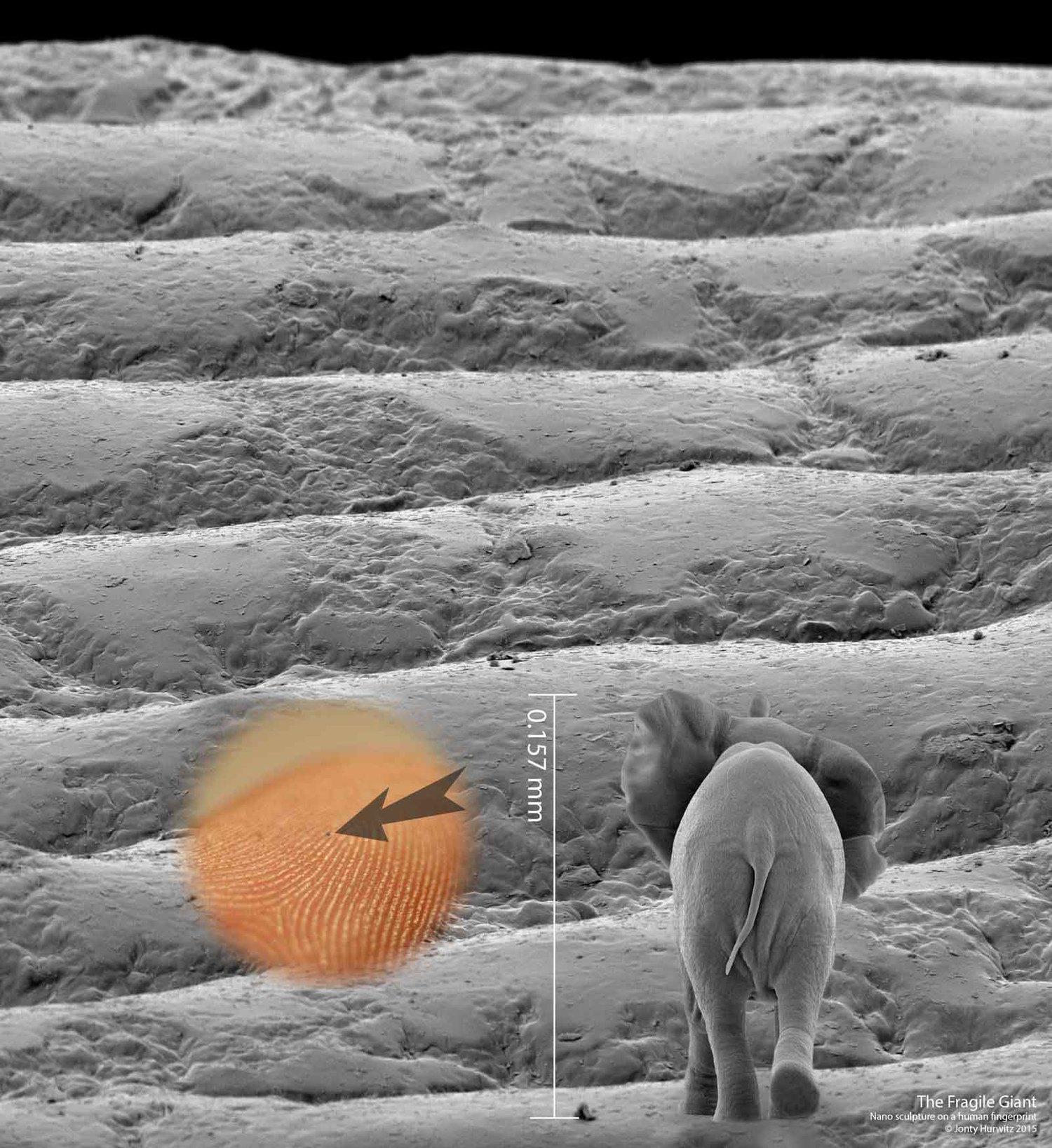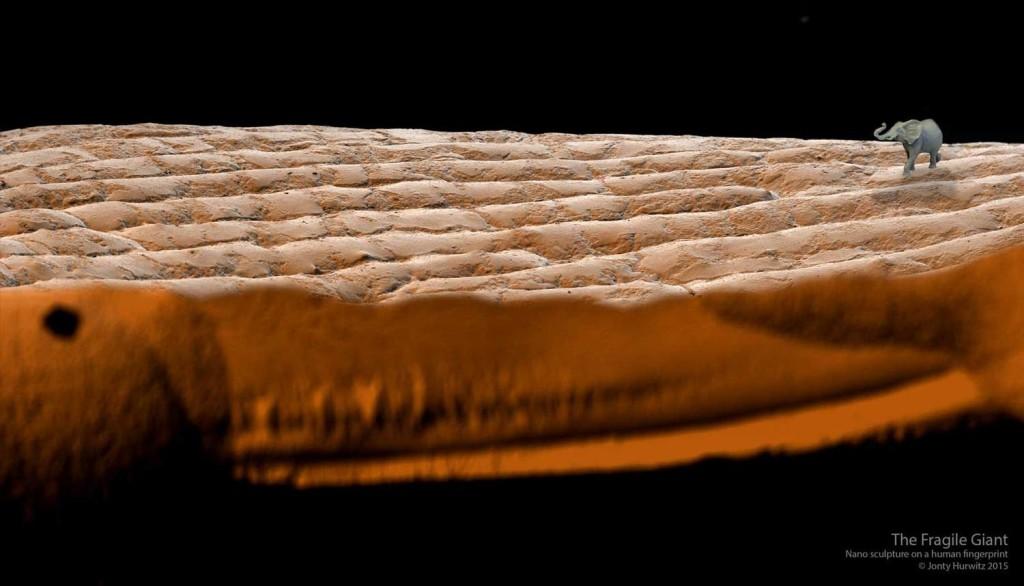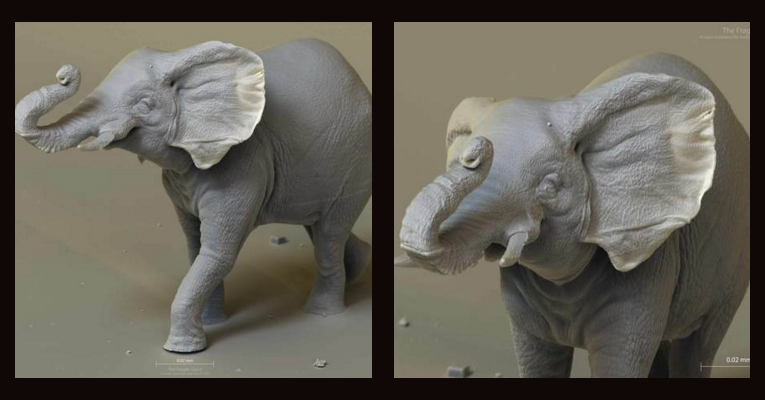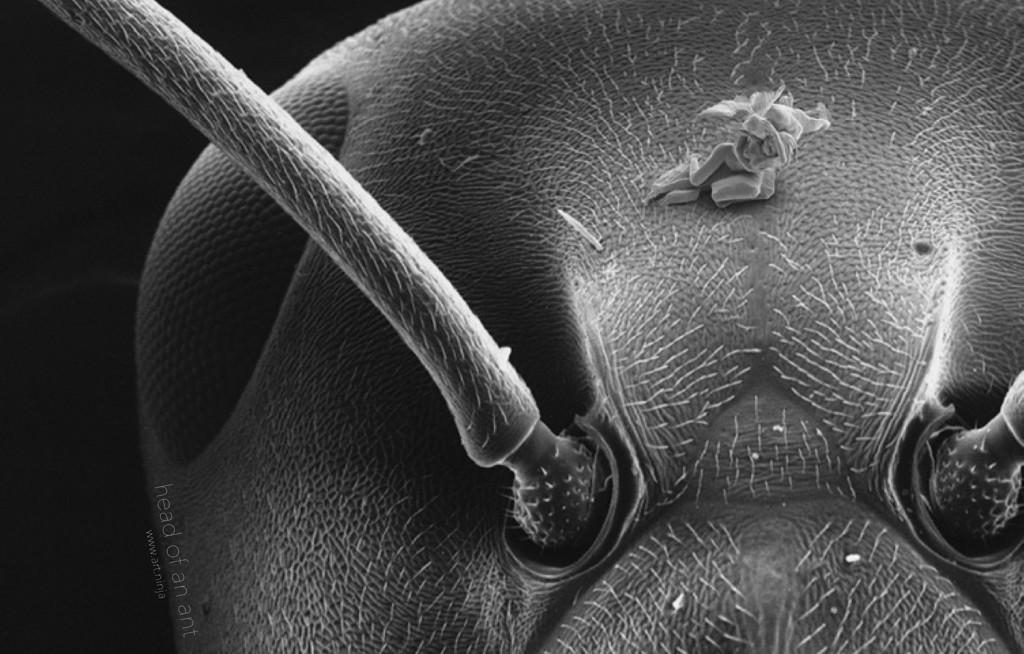For the Plight of the Elephant: Artist Jonty Hurwitz Takes to the 3D Printed NanoScale Again with ‘The Fragile Giant’
Artist Jonty Hurwitz has created a 3D printed elephant. And while that alone may be enough to gain your attention, the one he’s created will have you squinting–in amazement. Fabricated on the nano-scale, the ‘Fragile Giant’ is a spectacular specimen in miniature; in fact, it’s as minute as “a speck of dust that disappears in the wind.”
Causing you to take a very close look at his work–which is rendered in one tenth of a millimeter–Jonty Hurwitz is using this as an opportunity to call swift attention to the increasingly rapid demise of the elephant in Africa. Hurwitz quotes National Geographic as an inspiration on his website, stating that “Ivory-seeking poachers have killed 100,000 African elephants in just three years, according to a new study that provides the first reliable continent-wide estimates of illegal kills.”
Hurwitz makes a very dramatic–and important–point that all should heed: we as humans have created virtual magic with technology, yet we can’t stop the slaughter of a large portion of the population of elephants–and eventually all of it–by other greedy humans? It’s a well-known fact that the elephant is a highly intelligent, organized, and family-oriented animal, recognized in cultures and history for as long as we know.
 Although revered and honored by many, there are those who would destroy the magnificent and sensitive mammal, with ongoing hunting and killing persisting in Africa to sell tusks and valuable ivory to Asia. Poachers are unfortunately also well-equipped with formidable and expensive technology of their own, from complex GPS and tracking devices to helicopters, which makes trapping and killing the animals all that much easier.
Although revered and honored by many, there are those who would destroy the magnificent and sensitive mammal, with ongoing hunting and killing persisting in Africa to sell tusks and valuable ivory to Asia. Poachers are unfortunately also well-equipped with formidable and expensive technology of their own, from complex GPS and tracking devices to helicopters, which makes trapping and killing the animals all that much easier.
We’ve been following Hurwitz’s art for quite some time, as he delights in working with 3D printed sculptures that attract attention due to their pure tininess, with multiple intricacies like nano-replicas of “Psyche Revived by Cupid’s Kiss” by Antonia Canova. That was one in a series of seven sculptures made in the tiniest 3D printed microscopic prints you could imagine (and among the coolest we’ve ever seen), yet both Hurwitz and a colleague upon helping him view the pieces were horrified to drop and lose them forever while making a quick movement in readjustment. As we see though, Hurwitz dusted himself off from the loss of losing what he thought were some of the most beautiful things in the world–a pretty substantial loss for an artist–but he went on to make another impressive work, as we see with the ‘Fragile Giant.’
The technology that went into making the 3D printed elephant, as with his other works, is called multiphoton lithography–and put your thinking caps on everyone, cause it involves stuff like quantum physics, in a technique he discovered in working with numerous scientists and the Institute of Microstructure Technology at the Karlsruhe Institute of Technology.
“If you illuminate a light-sensitive polymer with Ultra Violet wavelengths, it solidifies wherever it was irradiated in a kind of crude lump,” states Hurwitz in his note ‘For the Geeks,’ on his website. “Some of you may have experienced a polymer like this first hand at the dentist when your filling is glued in with a UV light.”
“If however you use longer wavelength intense light, and focus it tightly through a microscope, something wonderful happens: at the focus point, the polymer absorbs two photons and responds as if it had been illuminated by UV light, namely it will solidify. This two photon absorption occurs only at the tiny focal point–basically a tiny 3D pixel (called a Voxel). The sculpture is then moved along fractionally by a computer controlled process and the next pixel is created. Slowly, over hours and hours the entire sculpture is assembled pixel by pixel and layer by layer.”
 Along with that, Hurwitz and his brilliant team of artists and scientists have also created what is an incredibly lovely film of the nano sculpture. This was completed with a rotating Piezo stage that spins at a precision of ‘below one ten thousandth of a degree.’ It is a painstaking process, as they mention–and this is undeniable–as each frame takes several minutes.
Along with that, Hurwitz and his brilliant team of artists and scientists have also created what is an incredibly lovely film of the nano sculpture. This was completed with a rotating Piezo stage that spins at a precision of ‘below one ten thousandth of a degree.’ It is a painstaking process, as they mention–and this is undeniable–as each frame takes several minutes.
“…the creation of these films involves a wonderfully diverse set of technologies from bespoke electronics and software, to quantum physics and leading-edge scientific tool to modern special effects,” states Hurwitz in his unique note. “A feat of art and science at its most beautiful.”
Hurwitz is obviously engaged in an intricate study of scale, and his way of integrating it into exposing the issue with elephant poaching is quite genius. Keep in mind, again for perspective, that this piece is small enough to be glimpsed in between the grooves of a fingerprint. It’s barely visible to your eye. A work of beauty and something meant to better the world in making a statement, this is quite a recovery from the loss of his seven previous sculptures which now live in posterity as only a memory, but also a tale of both tragedy and irony; in fact, all of the pieces present emotion and story, while provoking you to think about the impact technology of different kinds can have on our world overall–in the hands of good and bad.
What are your thoughts on this incredibly tiny 3D print. Let us know in the 3D Printed Elephant forum thread on 3DPB.com.
Subscribe to Our Email Newsletter
Stay up-to-date on all the latest news from the 3D printing industry and receive information and offers from third party vendors.
You May Also Like
3D Printed Heat Spreader Could Improve Efficiency of Electronics
The low-hanging fruit for decarbonization has long been improving the efficiency of existing systems, hence the justification for LED lights and ENERGY STAR certified appliances. While such minor moves are...
3D Printing News Unpeeled: Marine Gearboxes, 3D Printed Motors and $1.7 Million in Seed Funding
UK based Equipmake just released their Ampere-220 e-axle system. The system, which is meant for high performance electric cars, was similar to one released on the Ariel HIPERCAR. It has...
CEAD Unveils 36-Meter-Long 3D Printer for Abu Dhabi’s Al Seer Marine
CEAD, a Dutch original equipment manufacturer dedicated to large-format 3D printers, has unveiled what it claims to be the world’s largest robotic arm-based 3D printer. At 36 meters long and...
3D Printed Biocomposites Could Help Reduce Marine Plastic Pollution
Concerns about the impact of plastic litter and microplastics in the oceans are at the forefront of environmental study. For decades, the marine environment has suffered from the degradation of...







































